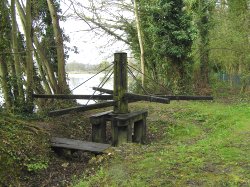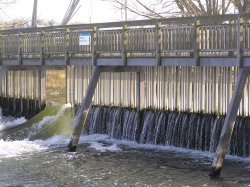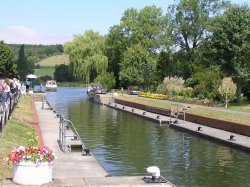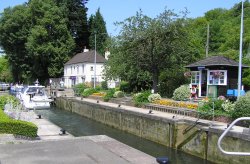

General Information. |
|
The River Thames - Lock Details. |
|
The River Thames - Lock Statistics. |
|
The River Thames - Planned Lock Closures 2009-2010. |
The River Thames has been used for navigation for centuries. The ease, which the lock system make travelling along it, is something which nowadays we take for granted. They have, however, evolved gradually.
It is known that the Vikings, during their raids, overcame the problem of shallow water by building dams which helped raise the water level.
Later mills and fisheries developed and with them came weirs. The millers needed weirs to provide a sufficient head of water to turn their mill-wheels whilst the fishermen found that good catches could be obtained by setting traps across the river. Although these weirs helped raise the level of the water, which in some cases was a benefit to overcome shallows, they also obstructed the boat traffic from travelling freely. The solution was to make a section of the weir removable to allow the boats to pass through.
A large wooden beam was laid on the river bed (sometimes encased in a masonary 'sill') with slots just over 4 inches (100mm) square and about 2 feet (600mm) apart. A similar beam was positioned over it and above the water level. This beam, which was fixed to the bank or part of the weir, was removable in some way - either swung to one side or pulled across to rest upon the top of the remainder of the weir. 4 inch (100mm) squared vertical timbers were then fixed into the slots in the lower beam with their tops resting against the upper beam. The pressure of the water held them in position. These were called 'rymers'. A series of boards about 2 feet (600mm) wide and 3 feet (900mm) deep, attached to long poles, were then placed against the rymers to hold back the water. These were called 'paddles'.
When a boat needed to pass through, the paddles were removed one by one over a width of about 20 feet (6m) - about 10 sets of paddles, the rymers were taken out and the upper beam removed or swung out of the way. There would then be a 'flash' of water through the opening and boats going downstream would shoot the weir. Boats going upstream would wait for the rush of water to subside and then they would be hauled through the opening either by a gang of men, a team of horses or by a winch or capstan.
This was known as a flash lock. It was rather a dangerous manoeuvre for the boats, but one that solved the problem. The operation of a flash lock was also hazardous and required great skill and strength. The timing of the removal of the paddles was quite critical: if it was done too early the level of water in the reach above may have dropped too soon and the boat could go aground before it reached the lock.
 |
The original flash lock capstan used at the Hurley flash lock, prior to the first pound lock being built at this location in 1773, is the last surviving flash lock capstan in existence on the Thames and is situated next to the River in the grounds of Wittington House between Henley and Marlow. It was restored in 1999 and is now maintained by SAS UK, the owners of the Wittington Estate. |
 |
The Capstan in 1987 before it was restored |
Hurley Flash Lock Capstan in April 2005 |
 |
The last flash lock, at Eaton Hastings, was not finally removed until 1938. It is interesting to note however, that the weirs at Northmoor, Rushy and Radcot are still operated using only paddles and rymers. |
 |
The Paddle and Rymer Weir at Northmoor |
The Unused Paddles at Northmoor Weir |
The next stage in lock development is what we have today, the pound lock.



Basically a pound lock is a man-made chamber with heavy gates at either end. There are sluices within these huge gates, which can be opened and closed, to control the flow of water into and out of the chamber.
 |
A Simplified Cutaway Diagram of an Electro-Hydraulic Lock on the River Thames |
Pound locks are reputed to have originated in China but the first known example on the River Lek in Holland dates from 1373. Pound locks were also in use in Italy in the fifteenth century using portcullis type gates but Leonardo da Vinci is credited with the invention of the pound lock using mitre gates with built-in vertical sluices as he prepared plans for such a lock (San Marco Lock) on the Naviglio Interno in Milan in 1495. The first pound locks to be used in England were built in 1564 by John Trew on the Exeter Ship Canal.
The first three pound locks on the Thames were built by the Oxford - Burford Commission in the 1630's at Iffley, Sandford and Abingdon. The lock at Abingdon was built on the Swift Ditch where remains of the lock can still be seen.
The Thames Navigation Commissioners (the forerunners of the Thames Conservancy) built their first series of pound locks between Sonning and Maidenhead in 1772 and 1773. The locks in this series comprised Sonning, Shiplake, Marsh, Hambleden, Hurley, Temple, Marlow and Boulter's. Their second series of pound locks, built between 1778 and 1789, was from Dorchester to Reading and included Day's, Benson, Cleeve, Goring, Whitchurch, Mapledurham and Caversham. Their third series comprised St.John's, Buscot, Rushy, Pinkhill, Godstow and Osney and were built between 1790 - 1791. Abingdon was also built in 1790 and Culham and Romney were built between 1798 and 1810 but these were not part of any series. The final series of locks built by the Thames Navigation Commissioners were built between 1817 and 1845 and included Clifton, Cookham, Bray, Boveney, Old Windsor and Bell Weir.
The Corporation of the City of London (the authority that controlled the River below Staines until 1857) built their first pound Lock at Teddington in 1811, nearly 180 years after the building of the first pound locks by the Oxford-Burcot Commission. Between 1812 and 1815 the Corporation of the City of London built a further five locks (Penton Hook, Chertsey, Shepperton, Sunbury and Molesey) within their jurisdiction.
The Thames Conservancy built their first locks between 1892 and 1898 and these included Grafton, Radcot, Shifford and Northmoor. It was not until 1927/28 that they built Eynsham and King's locks.
There are 44 locks on the Non tidal Thames. The first upstream lock is St John's at Lechlade shown here, which is 73.10m above sea level. The final one downstream is Teddington which is only 4.30m above sea level. |
 |
St. John's Lock |
Buscot Lock, which is 33.47m long and 4.47m wide, is the smallest. Apart from the Teddington Barge Lock, which is nearly 200m long, Molesey Lock, the first lock above Teddington, is the largest on the river at 81.78m long and 7.56m wide.
The lock with the greatest fall is Sandford near Oxford with a drop of 2.69m. That with the smallest is Cleeve, upstream of Goring, with a drop of only 0.69m.
 |
In 1956, Mapledurham Lock had electro-mechanical gear installed which made it the first power operated lock on the Thames. It was not very successful and so in 1961 the first, more reliable, hydraulic system was introduced and fitted to Shiplake Lock. It is this system that, over time, has been fitted to all the Locks from Teddington to Godstow but above Godstow the locks are still operated manually. |
 |
Mapledurham Lock |
Shiplake Lock |
On the River Thames we are lucky as all locks are manned, unlike the canal system where boaters have to operate the winding gear to open and close the gates and sluices.
 |
As you approach the lock slow down and make sure the fenders are in place. If the lock gates are closed you will have to pull into the lay-by, if they are open, watch the lock-keeper. He will signal which side of the lock you are to go. Then all the skipper has to do is to control the boat as the crew hopefully throw the lines over the bollards. But don't worry, at the height of the season there is often a Summer Assistant to take the rope from you. Don't fasten off the lines, hold them so you can adjust as the boat rises or falls in the lock. The skipper should switch off engines. |
Sonning Lock |
Boats that use the canal system, where they remain on, don't realise that it is a requirement on the Thames. Certainly it isn't very pleasant to be breathing in diesel fumes, if a skipper forgets. Once the correct level has been reached, the lock-keeper will open the lock gates so boats can continue their journey. |
 |
Marsh Lock |
With the exception of Teddington Lock, which is manned 24 hours a day, lock keepers on the Thames are usually on duty during the following hours:-
January to March |
09.15 - 16.00 |
(If Easter falls in March, the opening hours over the holiday are 09.00 - 17.30) |
|
April |
09.00 - 17.30 |
May |
09.00 - 18.30 |
June to August |
09.00 - 19.00 |
September |
09.00 - 18.00 |
October |
09.00 - 17.00 |
November and December |
09.15 - 16.00 |
Locks are closed for lunch between 13.00 and 14.00 every day except in the summer, when 'Summer Assistants' may be on duty in some of the busier locks.
If you arrive at a lock after the lock-keeper has gone off duty, it is possible to operate the gates and sluices yourself. But, below Godstow where the locks are mechanically operated, you won't always have the luxury of electricity that the lock-keeper has. Only those locks that have power available to the public - see below - have the benifit of electricity. On all the other locks the winding gear has to be used . It can be rather tiring work and certainly will induce a healthy appetite. Instructions for the public use of locks outside normal hours are given on the control pedestal.
The locks that have power available to the public are Molesey, Sunbury, Shepperton, Chertsey, Penton Hook, Bell Weir, Old Windsor, Romney, Boulters, Hambleden and Sonning. At these locks the power will be available from 0700hrs to 2200hrs during British Summer Time and from 0600hrs to 2100hrs during the winter months.
When you work the locks yourself you have to leave the lock empty with both gates closed.
Whenever possible Lock Maintenance and repair is carried out during the winter months in order to keep disruption to a minimum as lock closures are usually required. The EA announce in the Autumn a list of planned closures.
The River Thames - Lock Details. |
|
The River Thames - Lock Statistics. |
|
The River Thames - Planned Lock Closures 2009-2010. |
|
To return to The River Thames page. |
Copyright © The Harts